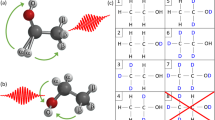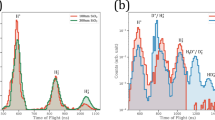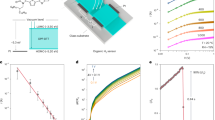Abstract
J. J. THOMSON1 discovered the triatomic molecule of hydrogen by the positive ray parabolic method. It was later confirmed by Dempster2, Duane and Wendt3, and several others. Its occurrence is very frequently noted in discharge tubes, but the optimum conditions are not well defined. While investigating the Doppler effect in hydrogen positive rays, using a Wien type of discharge tube, maximum Doppler displacements corresponding to H3+ molecules in the discharge space were observed. The accompanying graph gives the maximum Doppler displacements recorded in the Hδ line of the Balmer series. A Steinheil three-prism glass spectrograph was used at two different dispersions, namely, 7.6 A. and 27.2 A. per mm. in the Hδ region.
This is a preview of subscription content, access via your institution
Access options
Subscribe to this journal
Receive 51 print issues and online access
$199.00 per year
only $3.90 per issue
Buy this article
- Purchase on SpringerLink
- Instant access to full article PDF
Prices may be subject to local taxes which are calculated during checkout
Similar content being viewed by others
References
Thomson, J. J., Proc. Roy. Soc., A, 89, 1 (1913).
Dempster, A. J., Phil. Mag., 31, 438 (1916).
Duane, W., and Wendt, G. L., Phys. Rev., 10, 116 (1917).
Dasannacharya, B., and Dakshinamurti, C., Nature, 154, 22 (1944).
Hornwell, G. P., Phys. Rev., 29, 832 (1927).
Author information
Authors and Affiliations
Rights and permissions
About this article
Cite this article
DAKSHINAMURTI, C. Triatomic Hydrogen and Doppler Effect in Hydrogen Positive Rays. Nature 159, 27–28 (1947). https://doi.org/10.1038/159027a0
Issue date:
DOI: https://doi.org/10.1038/159027a0



